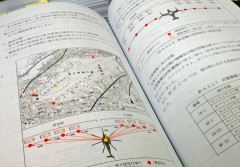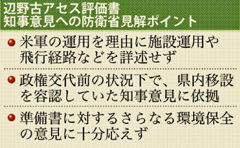The full text of the Henoko environmental impact report revealed

The environmental impact report, which the Okinawa Defense Bureau submitted to the Okinawa Prefectural government, consists of three parts. One includes a description of the MV-22 Osprey (upper right) and a simplified schematic of the CH-53 helicopter (bottom left).
January 8, 2012 Ryukyu Shimpo
On January 7, the full text of the written evaluation of the environmental impact of the reclamation of the coastal area of Henoko in Nago, which the Okinawa Defense Bureau has submitted to Okinawa Prefectural Government (OPG), was revealed. With regard to the deployment of the MV-22 Osprey vertical take-off and landing transport aircraft to the Futenma Replacement Facility, something which is mentioned for the first time, the environmental impact report estimates that low-frequency sounds generated by the Osprey could possibly affect the people living in Abu Village of Nago both on a psychological and physiological level. It is pointed out that these sounds could cause health hazards such as the disturbance of sleep and that they could possibly have a physical impact, such as in the form of building vibration in the ten spots that were surveyed, including the Okinawa National College of Technology. With regard to the Weighted Equivalent Continuous Perceived Noise Level (WECPNL), the report estimates higher values at all 14 spots surveyed than predicted in the report’s preparatory documents, which indicates that the noise caused by the Osprey would clearly have a negative impact on the living environment. The Ryukyu Shimpo newspaper was able to procure the full text of the report by January 7.

In the Henoko environmental impact report, the Ministry of Defense presented its viewpoint in response to Okinawa Governor Hirokazu Nakaima’s statements of opinion.
With regard to aircraft noise levels, the report estimates a WECPNL of over 70, the standard value, which is specified by environmental quality standards for noise, in Camp Schwab and part of the Toyohara coastal area of Nago. However, the report claimed, “There are no villages in the regions with a WECPNL of over 70.”
On the other hand, the report does not clearly deny that flight paths would go over residential areas, stating, “Basically is it preferable to avoid flight paths over residential areas.” The report also states that if the U.S. military has “operational reasons” not to, aircraft do not need to follow the elliptical traffic pattern. The report does not include flight paths to other military bases in Okinawa such as the new helipads at Takae in Higashi Village in the U.S. Northern Training Area. It is possible that the noise level at the village area could actually be higher than the estimates.
Although the central government did present its views in response to Okinawa Governor Hirokazu Nakaima’s opinion of the preparatory documents of the environmental impact report, on this occasion more than 20 of the governor’s questions regarding his stance were unanswered.
It is also revealed that the operation of aircraft at the Futenma Replacement Facility is expected to cause radio disturbance. According to a survey conducted by the Nago municipal authorities and Ginoza Village, there is already interference to terrestrial digital television in these locations and it is predicted that flights by U.S. military aircraft could see the situation deteriorate even further. The report suggests that “Maximum avoidance measures possible to reduce the environmental impact could be adopted.”
The report indicates that the construction of the Futenma Replacement Facility could wipe out seaweed species on the total of 68.3 hectares and seagrass beds on the total of 78.1 hectares (degree of coverage more than five percent). The preparatory documents of the report stated that to avoid this situation and reduce the impact, the central government would implement countermeasures to expand the inhabitation range for seagrass beds in the surrounding areas. The governor doubted the viability of such countermeasures and requested the central government to review them and do a reevaluation. However, the Bureau dismissed this request, stating, “Within the bounds of possibility, maximum avoidance and reduction will be adopted.”
Until January 6, the Bureau submitted to OPG three parts of “the written evaluation on the environmental impact of the reclamation of the coastal area of Henoko, Nago for the construction of replacement facilities for the United States Marine Corps Air Station (USMCAS) Futenma,” the abstract and appendix, reference data (surveyed from fiscal 2009 to 2010) plus the additional report and its abstract.
Terminology: Environmental Impact Statement
In the case of large construction projects, the business operator (the central government) is required by law to investigate, predict and evaluate the environmental impact of related business procedures and to submit a report on this to the relevant prefectural and city governments as the final stage in the process. The governor must then return a written statement of opinion within 90 days of having received the evaluation report from the business operator in the case of reclamation projects based on law, and within 45 days for airport construction projects based on Prefectural Ordinance. The central government then makes amendments based on that written statement of opinion, and with this, the evaluation assessment is complete. The business operator (the central government) can then apply for approval from the governor for the construction landfill.
(English translation by T&CT, Mark Ealey)
Previous Article:Narcissus flowers in full bloom in Ie Island
Next Article:Wholesalers create new logo for Okinawa Churaumi tuna
[Similar Articles]
- Defense Minister says Henoko environmental impact report will be submitted to Okinawa Governor and Nago Mayor before the end of the year
- Defense Minister intends to submit Henoko environmental impact report before the end of the year
- Marine Corps plans to deploy Osprey aircraft to several U.S. military facilities in Okinawa
- Okinawa Prefectural Board rejects Futenma relocation plan after reviewing Henoko environmental impact report
- Okinawa Prefectural Board begins to review Defense Ministry’s environmental impact assessment report for relocation of Futenma U.S. Marine Corps Air Station
 Webcam(Kokusai Street)
Webcam(Kokusai Street)


